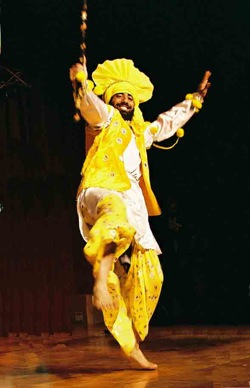Music and Dance from the Punjab

Bhangra was originally a Punjabi folk dance which has expanded in several ways. As far as dance is concerned, the term bhangra has expanded to include the style of music used to accompany bhangra dance. In terms of its reach, it has expanded beyond rural Punjab to become an internationally recognised style of song and dance.
History
Originally, the bhangra was just a folk dance that was confined to the Punjab during the harvest festival of Baisakhi. This was performed only by men, while the women would perform the giddha. Over the centuries, bhangra grew to encompass not only the giddha but a number of rural Punjabi folk dances. It grew in popularity, and expanded its range to the point where bhangra was then found over much of Northwest India and Pakistan. Furthermore, it could be performed on any festive occasion, and not just during the harvest festival.
The seeds of bhangra’s growth as an international art-form began not in India, but in Great Britain. The Indo-Pakistan expatriate community was lacking a clear symbol of its own ethnic identity. This community was starting to be comprised of second and third generation South Asians. They could no longer easily relate to a changed India or Pakistan, but were also unable to completely assimilate into traditional British society. They were struggling to have a clear symbol of their own identity. In this cultural vacuum, the bhangra grew to become an important symbol of their self identity.
Bhangra first began to make its mark internationally during the 1970’s. At this time, artists such as A.S. Kang and Kuldip Manak began to make a commercial success out of it. It was also in this period that bhangra began to be widely accepted as a genre of music rather than simply a dance form. In the next few decades bhangra grew into a truly international phenomenon. It is to be found wherever there is a large expatriate Indian community.
We have seen bhangra expand further until now it is almost a subculture. Implicit in the bhangra are not just the music and dance, but also a lifestyle. At first, this might be hard to conceive, but it certainly is not a unique occurrence. Perhaps the most well known example of this sort of thing was the disco movement in the late 70s; disco too encompassed music, dance, as well as a whole lifestyle.
Sub-Genres of Bhangra Dance
Bhangra is not a single dance but is actually composed of several sub-genera. Generally these are daankara, dhamal, gatka, giddha, jhumar, julli, kikli, luddi, and the saami. A brief description follows:
Daankara – The term “daankara”, is derived from the word “daan”, which means “stick”. As the name implies, this dance is performed with sticks. This dance tends to be done at weddings. It has a certain similarity to the dandiya raas of Gujarat.
Dhamal – The dhamal is a particularly energetic form of folk dance. This dance is done by the participants forming a circle. In this the dancers hold their hands in the air as they dance about, there are many interjections and much shouting.
Gatka – The gatka is dance that is performed with swords, daggers, or sticks. It is said that this dance was started after the martyrdom of the fifth Guru Arjun Dev.
Giddha – This is primarily a women’s dance.
Jhumar – The term “jhumar”, means to “swing”. The jhumar is a men’s dance that is performed at weddings and other festive events. It developed in the Sandalbar, and Balochistan area of Pakistan. It is characterised by a particular rhythm which is substantially slower than that which is normally used in bhangra.
Julli – Where most of the forms of bhangra are done by groups of people, julli may be done by a single person. It has its origins in the dance of the Muslim holy men and may be done from a sitting posture.
Kikli – The kikli is generally performed by women. For this, women lock there hands and swing about in circles. These are usually pairs of girls, but on occasion four girls may perform this move.
Luddi – The luddi is a dance that contains a vary characteristic posture of the bhangra. In this, the dancer has one hand behind their head and the other hand outstretched.
Saami – This is usually considered a women’s dance.
The Music of Bhangra
Today, bhangra is not just a dance but is also a musical style. As this music has become internationalised, it has undergone quite an evolution. Where it was once a purely folk music of Punjab, today elements of rap, hip-hop, and other commercial Western forms may be found enfolded within it.
Melodically the bhangra uses an extremely small number of notes. The range seldom extends an octave. Still, even with the limited number of notes used, the bhangra may be extremely expressive, due in great part to the lyrical nature of the songs.
The rhythms of bhangra tend to be very lively. They are usually based upon a very fast kaherava tal of eight beats. However this eight beat pattern is almost never performed straight, but usually incorporates a strong syncopation (i.e,. a heavy “swing”). The jhumar tends to be much slower, and at times utilises a half cycle version of punjabi theka (i.,e based upon eight beats rather than 16). At other times, the jhumar may be based upon a hemiola in a manner somewhat similar to the Gujarati raas music.
Selected Video
Other Sites of Interest
Building Hype: The Musicking Body In University Bhangra
Urban Myth : Bhangra and the Dhol Craze in the UK
Shaping Diasporic Sounds: Identity as Meaning in Bhangra
The Search for the 'Essence'of Bhangra through Panjabi heritage
Salsa/Bhangra: Transnational Rhythm Cultures in Comparative Perspective
